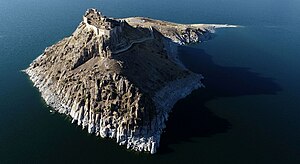Pertek Fortress
| Pertek Fortress | ||
|---|---|---|
|
Pertek Fortress from the south |
||
| Alternative name (s): | Pertag | |
| Castle type : | Hilltop castle | |
| Conservation status: | Ruin, partially restored | |
| Construction: | Natural stone blocks, partly clinker and tiles | |
| Place: | Pertek | |
| Geographical location | 38 ° 50 ′ 40 " N , 39 ° 16 ′ 18" E | |
| Height: | 873 m | |
|
|
||
The fortress of Pertek ( Turkish Pertek Kalesi ) is located on an island in the Keban reservoir . It was built in the Seljuk period.
history
The fortress was built in the 11th century under the rule of the Seljuk Beyliks of Mengücek . It was renewed and rebuilt in Ottoman times, probably in the 16th century, at the same time as the mosques of old Pertek . The origins of the plant are believed to be much earlier. According to the Italian archaeologist Roberto Dan, it shows characteristics of Urartean rock processing and was built to control mines, especially copper mines, which are located nearby.
investment
Originally the fortress was located high above the old town of Pertek (Eski Pertek) on the banks of the Euphrates . After the Keban reservoir was flooded in 1974, the town of Pertek sank in the lake and was re-established five kilometers away on the north side of the lake. Today the castle towers above the water surface on an island. It lies roughly on the border between the Turkish provinces of Elazığ in the south and Tunceli in the north.
The fortress is surrounded by walls made of natural stone blocks. Clinker bricks and blue tiles are said to have been used in the south walls. One entrance is in the northwest. Inside the castle there were cisterns and a stair tunnel. According to Evliya Çelebi , there is said to have been a sculpture of an eagle there.
The outer walls of the fortress have now been restored.
Web links
- Laurent Dissard: Submerged Stories from the Sidelines od Archaeological Science: The History and Politics of the Keban Dam Rescue Project (1967-1975) in Eastern Turkey
- Pertek Kalesi
Individual evidence
- ↑ Congrès international, conservation, réhabilitation, recycling . Presses Université Laval, 1981, p. 734 ( limited preview in Google Book search).
- ^ A b Roberto Dan: From Ṭušpa to Miliṭia. Further Considerations on the Westward Expansion of the Kingdom of Urartu In: ARAMAZD - Armenian Journal of Near Eastern Studies Vol. VII Issue 2, 2012 p. 60.
- ↑ Sights and sights in Tunceli
- ↑ a b Pertek Kalesi

